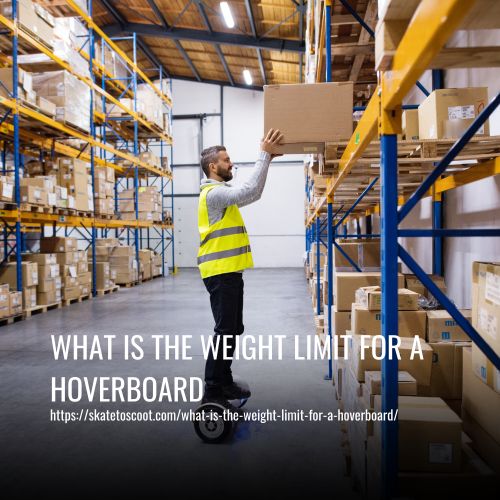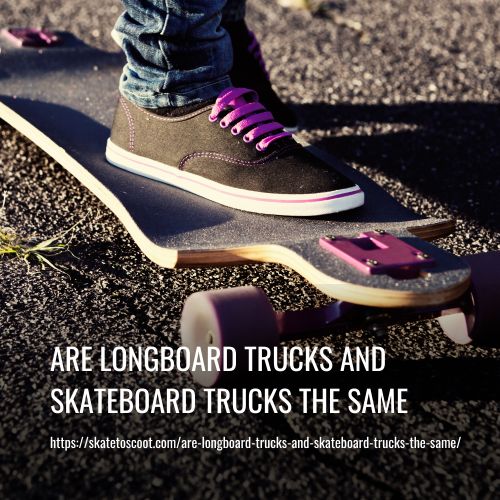As an Amazon Associate we earn from qualifying purchases.
Hoverboards do have weight limits that vary among different models and brands. The weight limit ranges from a few pounds to several hundred pounds, depending on the board’s construction and features.
It is essential to know the hoverboard’s maximum weight capacity, as exceeding the weight limit can damage the board, cause safety hazards, and void the warranty. Therefore, when purchasing a hoverboard, it is crucial to consider the rider’s weight and choose a product that is suitable for their size and weight.

How Do I Know The Weight Limit?
To know the weight limit of a hoverboard, you should check its specifications or manual. Generally, the weight limit for hoverboards ranges from 120 to 330 lbs depending on its wheel size. A 4.5″ hoverboard can hold up to 120 lbs, whereas a 10″ hoverboard can hold up to 330 lbs.
However, it is important to do your research and check the manufacturer’s suggestions before purchasing as each hoverboard has different weight limits. Additionally, premium hoverboards usually have higher weight limits than cheaper ones.
What is the Weight Limit for Hoverboards?
The weight limit for a hoverboard varies depending on the manufacturer and whether it’s designed for children, adults, or both. The maximum weight limit typically ranges between 120 to 300+ pounds. Different factors contribute to the weight limit, making it essential to check the specifications before making a purchase.
1. Intended Use:
Hoverboards are designed for different intended uses. Some hoverboards are made for children, having a maximum weight limit of around 150 to 180 pounds. Adult hoverboards, on the other hand, are built to withstand heavier loads, with some models allowing weight capacities up to 265 pounds or slightly higher. The average maximum weight for hoverboards is around 220 pounds, with only a few models accommodating riders up to 300 pounds.
2. Wheel Size:
The size of the wheels plays a significant role in a hoverboard’s weight limit capacity. 4.5-inch wheel size hoverboards can support up to 120 pounds which makes them suitable for children. 6.5-inch wheel size hoverboards can handle up to 220 pounds, which makes them a great option for teenagers and average-sized adults.
For those who are heavy set, 8.5-inch wheel size hoverboards can often handle weights up to 300 pounds or more, making them an ideal choice. Hoverboards with 10-inch wheels are often found in professional settings.
3. Price Matters:
When it comes to buying an affordable hoverboard, knowing the weight limit is crucial. To avoid any accidents, always check the hoverboard’s maximum weight capacity before purchasing. Many low-cost hoverboards have a weight limit that is not suitable for heavier riders due to their cheap components and weaker motors. It is wise to invest in a heavy-duty hoverboard if you are a heavy adult or planning to carry heavy loads.
4. Minimum Weight Limits:
Hoverboards come with a minimum weight limit to ensure safe riding. The minimum weight limit is usually around 44 pounds to prevent young children from engaging in the self-balancing mechanism. The requirement prohibits children below five years old from riding to avoid accidents. Despite the minimum weight limit, hoverboards are still a great option for children who satisfy the requirement.
What are the purposes of the weight limit?
Manufacturers set weight limits on hoverboards and self-balancing scooters for several reasons. The most important reason is to ensure rider safety by preventing the device from being overloaded and potentially malfunctioning. The weight limit is determined by the power of the motor and the battery, and exceeding the weight limit can cause the device to lose balance and topple over.
Additionally, the weight limit helps to prolong the battery life and maintain the performance of the hoverboard. By sticking to the weight limit, riders can enjoy a longer and smoother ride on their device.
1. Early Malfunctions:
If you exceed the hoverboard’s maximum weight capacity by 15 pounds or more, early malfunctions can occur within a few months of use. While the hoverboard won’t be destroyed instantly, going beyond the weight limit could significantly reduce its overall lifespan. It’s important to adhere to the manufacturer’s maximum weight limit to ensure that the device operates correctly and avoids frequent malfunctions.
2. Wear and Tear:
Frequently going beyond the weight limit of a hoverboard can cause significant wear and tear on its components. The damage can impact both the internal and external parts, such as the wheels, plastic or polycarbonate casing, brackets, screws, and wheel axles. Even the most robust hoverboards will become loose over time, making them less safe to ride. Hence, it is essential to follow the recommended weight limit to prevent premature wear and tear.
3. Safety Hazards:
It is crucial to abide by the recommended weight limit for hoverboards to prevent safety hazards. Hoverboards rely on self-balancing mechanisms that may malfunction when overloaded, resulting in uncontrolled movements. Moreover, surpassing the weight limit can lead to hoverboard breakdowns, causing potential accidents and injuries.
Is There A Minimum Weight For The Hoverboard?
Yes, there is a minimum weight restriction for hoverboards. This is to ensure the proper functionality of the controls and self-balancing sensors. Most manufacturers have set 44 pounds (20 kg) as the minimum weight for passengers, which also serves as a safety measure for children under the age of four or five.
The weight or age minimum is usually indicated on the packaging or in the manual, and it is important to follow these guidelines for safe hoverboard use. It is not recommended to cheat by adding weight as it can be dangerous, and all young children should wear helmets and pads when riding a hoverboard. Some hoverboards even have higher weight minimums, particularly for professional teenage and adult riders.
What Happens with the Hoverboard if I am Below the Required Weight?
If you are below the minimum weight, the hoverboard’s safety sensors will prevent it from operating. This ensures the safety of young children, as well as prevents accidental activation if an object falls onto the footplate. However, adults should also avoid trying to ride with their child between their legs, as this can unbalance the board and cause both passengers to fall. It is important not to rest objects on the board, even if you meet the weight requirement.
What Factors Need To Be Considered
When you are in the market for a hoverboard, there are several critical factors to consider before making your purchase. One of the most important is the weight limit, which will ultimately impact who can use it and, more importantly, how safely it can be ridden.
1. Who is the Intended User?
When selecting a hoverboard, the first thing to consider is the intended user. Most hoverboards are designed with specific age ranges and skill levels in mind, and this will impact the weight limits. If you’re an adult, be careful not to choose a hoverboard intended for children as it may not be able to support your weight capacity. Always choose a hoverboard that is designed with your intended weight in mind.
2. Wheel Size Matters:
Hoverboards come with various wheel sizes, and as such, the size of the wheel is the most critical factor that influences weight capacity. The larger the wheel, the more capable it is of sustaining a heavy load. All-terrain hoverboards are designed with larger, sturdier wheels that can support more significant weight capacity. Keep in mind that there are exceptions to this rule, so do your thorough research.
3. Size of the Hoverboard:
The size of the hoverboard is another important consideration when it comes to weight capacity. Typically, the larger the hoverboard, the more weight it can handle. However, that’s not always the case, and it’s essential to check the manufacturer’s weight limit specifications before purchasing your hoverboard. Keep these factors in mind, and you’ll be able to choose a hoverboard that is not only the right fit for your weight but for your intended use as well.
Why Do Hoverboards Have Weight Capacity Limits?
The weight capacity limit is an essential factor to consider when purchasing a hoverboard. But you may wonder why hoverboards have weight limits in the first place and why it is crucial to understand and follow them.
The reason behind the weight limit is safety concerns. The hoverboard’s motor and batteries can only support a specific weight capacity. If the rider exceeds this, the hoverboard’s performance may be compromised, leading to safety hazards like fire risks, overheating, and accidents. Therefore, it’s vital to adhere to the weight limit to ensure a safe riding experience for both you and your hoverboard.
What Could Happen If You Don’t Abide By The Limits?
Hoverboarding can be a thrilling and fun activity, but it’s essential to keep in mind that the machines have weight limits, which are assigned by the manufacturer. If you ignore these limits and use the hoverboard anyway, some pretty unpleasant things could happen. Here are some of the risks you take by exceeding the hoverboard weight limit:
- Injury Risk: If a person steps onto the hoverboard and its weight capacity is exceeded, the machine might malfunction. It could lose balance, accelerate abruptly, or shut down entirely, causing the rider to fall. This may result in severe injuries such as broken bones, concussions, contusions, and even brain damage.
- Damage to your Hoverboard: Exceeding the hoverboard’s weight limit will put undue pressure on the wheel assembly. The wheels, in particular, may deflate, and the board may begin to malfunction over rough terrain, eventually cracking down the middle. Additionally, overloading the battery by exceeding the weight limit could cause it to overheat and burst into flames, putting yourself and others at risk.
- Decreased Battery Performance: Even if the hoverboard does not immediately malfunction or collapse under the weight of a heavy rider, it will be less efficient in operation. Its speed might decline, and the battery life may decrease, affecting the device’s overall performance. Therefore, it is crucial to follow the weight restrictions set by the manufacturer to ensure optimal machine performance.
FAQ
Yes, there is always a weight limit for hoverboards. It can range from 120 pounds to 300 pounds or more, depending on the model and manufacturer. It’s crucial to research before buying a hoverboard, especially if you’re unsure of the weight limit, to ensure that you choose the appropriate board for your needs.
Yes, there is a minimum weight limit for hoverboards. Typically, the minimum weight limit for a hoverboard is 44 pounds. This is to ensure the self-balancing mechanisms and motor can function properly. Using a hoverboard below this weight limit can severely impact performance. It is important to check the weight limits of a hoverboard before purchasing it to ensure its suitability for the intended user.
When considering which hoverboard to choose for your weight, it is important to read up on the product’s weight limit before making a purchase. Typically, hoverboards with larger wheels are designed to support heavier body weights, while smaller wheels are meant for lighter riders or children. Be sure to select a hoverboard that matches your weight to maximize performance on the open road.
Experts suggest that children under eight years of age should not ride hoverboards due to the minimum weight limit and the fact that they are moving vehicles meant for road use. It’s important to consider safety when determining the appropriate age for hoverboard riders.
When considering hoverboards, it is essential to keep in mind that weight can significantly affect its overall performance. Typically, hoverboards weigh around 25 pounds, while cheaper models for kids can weigh less.
Conclusion:
When it comes to the weight limit for a hoverboard, it’s crucial to prioritize safety above all else. Always check the manufacturer’s guidelines and follow them diligently to ensure a smooth and enjoyable ride.
Remember, a hoverboard is not just a toy, it’s a mode of transportation that should be used responsibly. So, whether you’re a kid or an adult, choose the right hoverboard for your weight and enjoy the thrill of gliding effortlessly into the future!
Amazon and the Amazon logo are trademarks of Amazon.com, Inc, or its affiliates.



